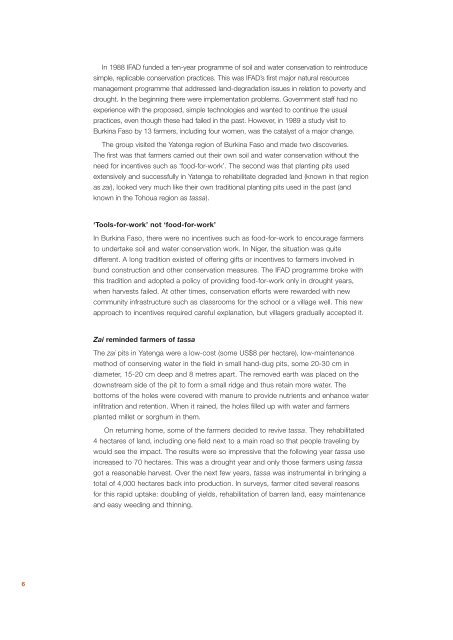Community-based natural resource management - International ...
Community-based natural resource management - International ...
Community-based natural resource management - International ...
You also want an ePaper? Increase the reach of your titles
YUMPU automatically turns print PDFs into web optimized ePapers that Google loves.
6<br />
In 1988 IFAD funded a ten-year programme of soil and water conservation to reintroduce<br />
simple, replicable conservation practices. This was IFAD’s first major <strong>natural</strong> <strong>resource</strong>s<br />
<strong>management</strong> programme that addressed land-degradation issues in relation to poverty and<br />
drought. In the beginning there were implementation problems. Government staff had no<br />
experience with the proposed, simple technologies and wanted to continue the usual<br />
practices, even though these had failed in the past. However, in 1989 a study visit to<br />
Burkina Faso by 13 farmers, including four women, was the catalyst of a major change.<br />
The group visited the Yatenga region of Burkina Faso and made two discoveries.<br />
The first was that farmers carried out their own soil and water conservation without the<br />
need for incentives such as ‘food-for-work’. The second was that planting pits used<br />
extensively and successfully in Yatenga to rehabilitate degraded land (known in that region<br />
as zai), looked very much like their own traditional planting pits used in the past (and<br />
known in the Tohoua region as tassa).<br />
‘Tools-for-work’ not ‘food-for-work’<br />
In Burkina Faso, there were no incentives such as food-for-work to encourage farmers<br />
to undertake soil and water conservation work. In Niger, the situation was quite<br />
different. A long tradition existed of offering gifts or incentives to farmers involved in<br />
bund construction and other conservation measures. The IFAD programme broke with<br />
this tradition and adopted a policy of providing food-for-work only in drought years,<br />
when harvests failed. At other times, conservation efforts were rewarded with new<br />
community infrastructure such as classrooms for the school or a village well. This new<br />
approach to incentives required careful explanation, but villagers gradually accepted it.<br />
Zai reminded farmers of tassa<br />
The zai pits in Yatenga were a low-cost (some US$8 per hectare), low-maintenance<br />
method of conserving water in the field in small hand-dug pits, some 20-30 cm in<br />
diameter, 15-20 cm deep and 8 metres apart. The removed earth was placed on the<br />
downstream side of the pit to form a small ridge and thus retain more water. The<br />
bottoms of the holes were covered with manure to provide nutrients and enhance water<br />
infiltration and retention. When it rained, the holes filled up with water and farmers<br />
planted millet or sorghum in them.<br />
On returning home, some of the farmers decided to revive tassa. They rehabilitated<br />
4 hectares of land, including one field next to a main road so that people traveling by<br />
would see the impact. The results were so impressive that the following year tassa use<br />
increased to 70 hectares. This was a drought year and only those farmers using tassa<br />
got a reasonable harvest. Over the next few years, tassa was instrumental in bringing a<br />
total of 4,000 hectares back into production. In surveys, farmer cited several reasons<br />
for this rapid uptake: doubling of yields, rehabilitation of barren land, easy maintenance<br />
and easy weeding and thinning.

















